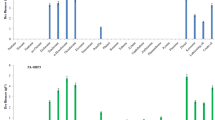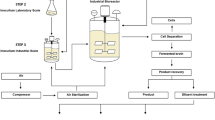Abstract
Biodegradation of petroleum hydrocarbons as a decontamination mechanism is a relatively slow process. This study aimed to investigate the impact of a tailored consortium of bacteria with higher capacities in biosurfactant production and biodegradation on the acceleration of the biodecontamination process. To this end, 18 biosurfactant producing bacteria were isolated from the crude oil-contaminated soil samples of Isfahan refinery, and the activity of the produced biosurfactants was measured in terms of surface tension reduction and emulsification E24 test. Then, the isolates screened for the biodegradation of kerosene hydrocarbons and chemical structure of the purified biosurfactants produced by the most efficient isolates were partially characterized. Next, the isolates were sorted based on their surfactant activity and biodegradation efficiency, and the higher ranked bacteria thus selected were utilized to form an efficient consortium removing hydrocarbons from the oil-contaminated soil samples in a slurry phase system. The consortium consisted of Bacillus subtilis tb1 and Pseudomonas aeruginosa species having the highest biodegradation capabilities and surface activities. The results revealed that the hydrocarbon removal efficiency of the consortium was at least 25 % higher than single species, and the final removal efficiency for the consortium could be reached in a considerably shorter time.






Similar content being viewed by others
References
Abbasnezhad H, Gray MR, Foght JM (2008) Two different mechanisms for adhesion of Gram-negative bacterium, Pseudomonas fluorescens LP6a to an oil–water interface. Colloids Surf B 62:36–41
Abouseoud M, Maachi R, Amrane A, Boudergua S, Nabi A (2008) Evaluation of different carbon and nitrogen sources in production of biosurfactant by Pseudomonas fluoresens. Desalination 223:143–151
Beam HW, Perry JJ (1974) Microbial degradation of cycloparaffinic hydrocarbons via co-metabolism and commensalism. J Gen Microbiol 8:163–169
Binazadeh M, Karimi IA, Li Z (2009) Fast biodegradation of long chain n-alkanes and crude oil at high concentrations with Rhodococcus sp. Moj-3449. Enzyme Microb Technol 45:195–202
Biria D, Maghsoudi E, Roostaazad R (2013) Application of power law logistic model to growth kinetics of Bacillus licheniformis MS3 on a water insoluble substrate. Chem Eng Commun. doi:10.1080/00986445.2013.819351
Bordoloi NK, Konwar BK (2009) Bacterial biosurfactant in enhancing solubility and metabolism of petroleum hydrocarbons. J Hazard Mater 170:495–505
Calvo C, Manzanera M, Silva-Castro GA, Uad I, González-López J (2009) Application of bioemulsifiers in soil oil bioremediation processes future prospects. Sci Total Environ 407:3634–3640
Cameotra SS, Singh P (2009) Synthesis of rhamnolipid biosurfactant and mode of hexadecane uptake by Pseudomonas species. Microb Cell Fact 8:16. doi:10.1186/1475-2859-8-16
Cerqueira VS, Hollenbach EB, Maboni F, Vainstein MH, Camargo FAO, Peralba MCR, Bento FM (2011) Biodegradation potential of oily sludge by pure and mixed bacterial cultures. Bioresour Technol 102:11003–11010
Chen J, Yang Q, Huang T, Zhang Y, Ding R (2011) Enhanced bioremediation of soil contaminated with viscous oil through microbial consortium construction and ultraviolet mutation. World J Microbiol Biotechnol 27:1381–1389
Das N, Chandran P (2011) Microbial degradation of petroleum hydrocarbon contaminants: an overview. Biotechnol Res Int. doi:10.4061/2011/941810
Dubois M, Gills KA, Hamilton JK, Rebers PA, Smith F (1956) Colorimetric method for determination of sugar and related substances. Anal Chem 28:350–356
Ghazali FM, Abdul-Rahman RNZ, Salleh A, Basri M (2004) Biodegradation of hydrocarbons in soil by microbial consortium. Int Biodeterior Biodegradation 54:61–67
Gojgic-Cvijovic GD, Milic JS, Solevic TM, Beskoski VP, Ilic MV, Djokic LS, Narancic TM, Vrvic MM (2012) Biodegradation of petroleum sludge and petroleum polluted soil by a bacterial consortium: a laboratory study. Biodegradation 23:1–14
Izquierdo P, Feng J, Esquena J, Tadros TF, Dederen JC, Garcia MJ, Azemar N, Solans C (2005) The influence of surfactant mixing ratio on nano-emulsion formation by the pit method. J Colloid Interface Sci 285:388–394
Ko KS, Oh WS, Lee MY et al (2006) Bacillus infantis sp. nov. and Bacillus idriensis sp. nov., isolated from a patient with neonatal sepsis. Int J Syst Evol Microbiol 56:2541–2544
Kumar A, Bisht BS, Joshi VD, Dhewa T (2011) Review on bioremediation of polluted environment: a management tool. Int J Environ Sci 1:1079–1093
Lowry OH, Rosebrough NJ, Farr AL, Randall RJ (1951) Protein measurement with the Folin phenol reagent. J Biol Chem 193:265–275
Makkar RS, Rockne KJ (2003) Comparison of synthetic surfactants and biosurfactants in enhancing biodegradation of polycyclic aromatic hydrocarbons. Environ Toxicol Chem 22:2280–2292
Mattei M, Kontogeorgis GM, Gani R (2014) A comprehensive framework for surfactant selection and design for emulsion based chemical product design. Fluid Phase Equilib 362:288–299
Mbadinga SM, Wang LY, Zhou L, Liu JF, Gu JD, Mu BZ (2011) Microbial communities involved in anaerobic degradation of alkanes. Int Biodeterior Biodegradation 65:1–13
Mehta SK, Kau G (2011) Microemulsions: thermodynamic and dynamic properties 381. In: Mizutani T (ed) Thermodynamics, 1st edn. InTech, Winchester, pp 381–407
Mishra S, Singh SN (2012) Microbial degradation of n-hexadecane in mineral salt medium as mediated by degradative enzymes. Bioresour Technol 111:148–154
Mukherjee S, Das P, Sen R (2006) Towards commercial production of microbial surfactants. Trends Biotechnol 24:509–515
Mulligan CN, Yong RN, Gibbs BF (2001) Surfactant enhanced remediation of contaminated soil. Eng Geol 60:371–380
Noha HY, Duncana KE, Naglea DP, Savagea KN, Knapp RM, McInerney MJ (2004) Comparison of methods to detect biosurfactant production by diverse microorganisms. J Microbiol Methods 56:339–347
Palittapongarnpim M, Upatham PP, Tangbanluekal ESL (1998) Biodegradation of crude oil by soil microorganisms in the tropic. Biodegradation 9:83–90
Rahman KSM, Thahira-Rahman J, Lakshmanaperumalsamy P, Bana IM (2002) Towards efficient crude oil degradation by a mixed bacterial consortium. Bioresour Technol 85:257–261
Rayu S, Karpouzas DG, Singh BK (2012) Emerging technologies in bioremediation: constraints and opportunities. Biodegradation 23:917–926
Robles-González IV, Fava F, Poggi-Varaldo HM (2008) A review on slurry bioreactors for bioremediation of soils and sediments. Microb Cell Fact 7:5–23
Ron EZ, Rosenberg E (2002) Biosurfactants and oil bioremediation. Curr Opin Biotechnol 13:249–252
Ruggeri C, Franzetti A, Bestetti G, Caredda P, La Colla P, Pintus M, Sergi S, Tamburini E (2009) Isolation and characterisation of surface active compound-producing bacteria from hydrocarbon-contaminated environments. Int Biodeterior Biodegradation 63:936–942
Soberón-Chávez G, Lépine F, Déziel E (2005) Production of rhamnolipids by Pseudomonas aeruginosa. Appl Microbiol Biotechnol 68:718–725
Vasconcellos SP, Crespim E, Cruz GF, Senatore DB, Simioni KCM, Neto EVS, Marsaioli AJ, Oliveira VM (2009) Isolation, biodegradation ability and molecular detection of hydrocarbon degrading bacteria in petroleum samples from a Brazilian offshore basin. Org Geochem 40:574–588
Watanabe K (2001) Microorganisms relevant to bioremediation. Curr Opin Biotechnol 12:237–241
Acknowledgments
This research was partially supported by Isfahan Oil Refinery Company. The authors gratefully acknowledge the University of Isfahan research office for the financial support.
Author information
Authors and Affiliations
Corresponding author
Rights and permissions
About this article
Cite this article
Barin, R., Talebi, M., Biria, D. et al. Fast bioremediation of petroleum-contaminated soils by a consortium of biosurfactant/bioemulsifier producing bacteria. Int. J. Environ. Sci. Technol. 11, 1701–1710 (2014). https://doi.org/10.1007/s13762-014-0593-0
Received:
Revised:
Accepted:
Published:
Issue Date:
DOI: https://doi.org/10.1007/s13762-014-0593-0




